Castles in Glasgow
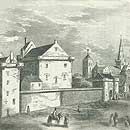
Bishop’s Castle (Also known as Glasgow Castle)
This Medieval castle served as the residence of the bishops and archbishops of Glasgow Cathedral until the Reformation, when the last Catholic archbishop, James Beaton, fled to France in about 1560. The castle was completely destroyed in the late 18th century, to make way for the Glasgow Royal Infirmary. The origins of the castle are unclear, but the first development was probably in the 12th century. It was recorded as a royal fortress in the mid 13th century. It had become an episcopal residence by the time of the Wars of Scottish Independence, when William Wallace recaptured the castle from the English in 1296. In 1301 the castle was garrisoned again by Edward I. In the 15th century a 5-storey keep was built by Bishop Cameron, this was later extended with additional fortifications and buildings, constructed by later bishops. Archbishop Beaton added a large corner tower, and Archbishop Dunbar built a round-towered gatehouse in 1544. The central keep served as the residence of the bishop, and was called the Bishop’s Palace. The castle played a role in the many political battles during the 16th century, including the protracted struggle between supporters of Mary, Queen of Scots, and her enemies. It changed hands six times between 1513 and 1570, and was occupied by French troops at one point. In 1544 it was defended against Regent Arran and in 1560 defended for Arran. The castle fell into disrepair during the 17th century, despite an attempt at repair by Archbishop Ross in the 1680s, and was gradually dismantled for its stone. It was finally demolished completely in 1789, to make way for the construction of the Glasgow Royal Infirmary. Foundations of the castle were discovered during excavations for the St Mungo Museum of Religious Life and Art in the 1980s. The base of the corner tower and curtain walls were uncovered A stone from the castle, with a modern plaque, is located in Cathedral Square, marking the location of the keep.
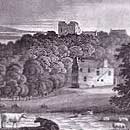
Cathcart Castle
Cathcart Castle was a 15th-century castle, located in what is now Linn Park in the Cathcart area of southern Glasgow. The castle was abandoned in the 18th century, and the remaining ruins were pulled down in 1980, leaving only foundations visible. The lands of Cathcart were held by the family of that name from the 12th century. In the mid-15th century the head of the family was raised to the peerage as Lord Cathcart, and it is believed that the castle was built at around this time. In 1546 the castle passed to the Semple family. Mary, Queen of Scots, is said to have spent the night before the Battle of Langside (1568) at Cathcart, and to have watched the battle from a nearby hill called the Court Knowe. The story is unlikely, however, as the Semples were supporters of Mary’s enemies. An alternative version of the story has the Queen living with her kinsfolk, the Stuarts of Castlemilk, whose defensive stronghold at the foot of the Cathkin Braes contained a chamber later known as Queen Mary’s Room, where Her Majesty supposedly lodged on the night before the Battle of Langside. The ceiling of this room was ornamented with the Arms of the Stuart monarchs of Scotland. In 1740 the Semples built Cathcart House, also since demolished, nearby, and moved out of the castle, leaving it to ruin. The newly created 1st Earl Cathcart bought back his ancestral home in 1814, although with the intention of selling off the stone rather than living in it. In 1866 the castle was still standing to 5 storeys, and was surrounded by outbuildings. The lands around the castle were purchased by Glasgow City Council in 1927, and added to Linn Park. In 1980 the remaining ruins were pronounced dangerous, and were pulled down by the council. The site is now a Scheduled Ancient Monument.
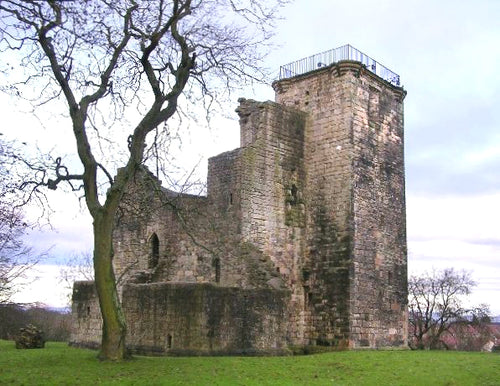
Crookston Castle
Crooks ton Castle is a late twefth-century timber castle with a defensive ringwork was built here by Robert de Croc. The ruins you see today are from the fifteenth century castle, built by the Stewarts of Darnley. Much damage was done to the castle when it was besieged by James IV in 1489; some of the towers were destroyed in the resulting bombardment. The castle was finally abandoned in the late sixteenth century. Crookston Castle is the second-oldest building in Glasgow (after the Cathedral).
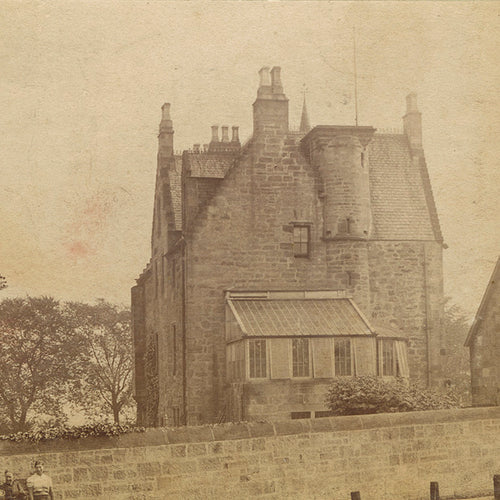
Haggs Castle
This was a 16th Century Tower House located in Pollokshields. This was restored and richly decorated in the 19th Century. It was built in 1585 by Sir John Maxwell of Pollok and his wife Margaret Conyngham (Cunningham). It was built to replace the Maxwell’s former residence, the Laigh Castle, a 14th-century building which stood to the west. Although built as the Maxwell’s main residence, it was later used as a jointure house, or dower house, being occupied by the lord’s widow. The Maxwells, a covenanting family, were fined for nonconformist activities, although the change of government resulting from the revolution of 1688 saved them from paying up. In 1753 Haggs in turn was replaced as a residence and abandoned when Pollok House was completed. The castle basement was later used as a smithy. In the 1850s the remains were consolidated, and in the 1860s the castle was restored for the Maxwell’s factor. Further restorations and additions were undertaken by Sir John Stirling-Maxwell in 1899–1900. A renovation scheme was prepared by architects MacGibbon and Ross, although their plans for a faithful restoration were not followed. In 1943 the castle was requisitioned by the military, and was later divided into flats. In 1972 the Glasgow Corporation bought the castle, converting it to serve as the Museum of Childhood. When this closed in 1998, the house once more became a private dwelling. 1585 by Sir John Maxwell of Pollok and his wife Margaret Conyngham (Cunningham). It was built to replace the Maxwell’s former residence, the Laigh Castle, a 14th-century building which stood to the west. Although built as the Maxwell’s main residence, it was later used as a jointure house, or dower house, being occupied by the lord’s widow.The Maxwells, a covenanting family, were fined for nonconformist activities, although the change of government resulting from the revolution of 1688 saved them from paying up. In 1753 Haggs in turn was replaced as a residence and abandoned when Pollok House was completed. The castle basement was later used as a smithy. In the 1850s the remains were consolidated, and in the 1860s the castle was restored for the Maxwell’s factor. Further restorations and additions were undertaken by Sir John Stirling-Maxwell in 1899–1900. A renovation scheme was prepared by architects MacGibbon and Ross, although their plans for a faithful restoration were not followed. In 1943 the castle was requisitioned by the military, and was later divided into flats. In 1972 the Glasgow Corporation bought the castle, converting it to serve as the Museum of Childhood. When this closed in 1998, the house once more became a private dwelling.
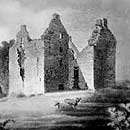
Partick Castle
Located in Partick, a Western suburb of Glasgow. It was built in 1611 for the Glasgow benefactor George Hutcheson and situated on the west bank of the River Kelvin. Writing in the early eighteenth century, Hamilton of Wishaw described the building: “…where Kelvin falls into Clyde, is the house of Pertique, a well-built and convenient house, well planted with barren timber and large gardens, which are enclosed with stone walls, and which formerly belonged to George Hutcheson in Glasgow, but now to John Crawford of Myltoun.” According to the local historian James Napier, it was left empty in 1770 and was unroofed and in ruins by 1783. It was demolished during the 1830s.
